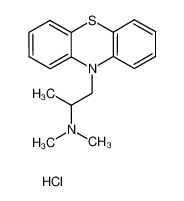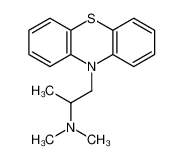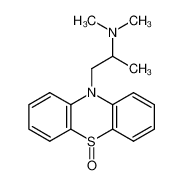| Product name | promethazine hydrochloride |
|---|
| Product number | - |
|---|---|
| Other names | 10H-Phenothiazine-10-ethanamine, N,N,α-trimethyl-, monohydrochloride |
| Identified uses | For industry use only. |
|---|---|
| Uses advised against | no data available |
| Company | MOLBASE (Shanghai) Biotechnology Co., Ltd. |
|---|---|
| Address | Floor 4 & 5, Building 12, No. 1001 North Qinzhou Road, Xuhui District, Shanghai, China |
| Telephone | +86(21)64956998 |
| Fax | +86(21)54365166 |
| Emergency phone number | +86-400-6021-666 |
|---|---|
| Service hours | Monday to Friday, 9am-5pm (Standard time zone: UTC/GMT +8 hours). |
Acute toxicity - Oral, Category 4
Skin irritation, Category 2
Skin sensitization, Category 1
Eye irritation, Category 2
Acute toxicity - Inhalation, Category 4
Specific target organ toxicity – single exposure, Category 3
Hazardous to the aquatic environment, long-term (Chronic) - Category Chronic 2
2.2 GHS label elements, including precautionary statements| Pictogram(s) |   |
|---|---|
| Signal word | Warning |
| Hazard statement(s) | H302 Harmful if swallowed H315 Causes skin irritation H317 May cause an allergic skin reaction H319 Causes serious eye irritation H332 Harmful if inhaled H335 May cause respiratory irritation H411 Toxic to aquatic life with long lasting effects |
| Precautionary statement(s) | |
| Prevention | P264 Wash ... thoroughly after handling. P270 Do not eat, drink or smoke when using this product. P280 Wear protective gloves/protective clothing/eye protection/face protection. P261 Avoid breathing dust/fume/gas/mist/vapours/spray. P272 Contaminated work clothing should not be allowed out of the workplace. P271 Use only outdoors or in a well-ventilated area. P273 Avoid release to the environment. |
| Response | P301+P312 IF SWALLOWED: Call a POISON CENTER/doctor/…if you feel unwell. P330 Rinse mouth. P302+P352 IF ON SKIN: Wash with plenty of water/... P321 Specific treatment (see ... on this label). P332+P313 If skin irritation occurs: Get medical advice/attention. P362+P364 Take off contaminated clothing and wash it before reuse. P333+P313 If skin irritation or rash occurs: Get medical advice/attention. P305+P351+P338 IF IN EYES: Rinse cautiously with water for several minutes. Remove contact lenses, if present and easy to do. Continue rinsing. P337+P313 If eye irritation persists: Get medical advice/attention. P304+P340 IF INHALED: Remove person to fresh air and keep comfortable for breathing. P312 Call a POISON CENTER/doctor/…if you feel unwell. P391 Collect spillage. |
| Storage | P403+P233 Store in a well-ventilated place. Keep container tightly closed. P405 Store locked up. |
| Disposal | P501 Dispose of contents/container to ... |
none
3.Composition/information on ingredients 3.1 Substances| Chemical name | Common names and synonyms | CAS number | EC number | Concentration |
|---|---|---|---|---|
| promethazine hydrochloride | promethazine hydrochloride | 58-33-3 | none | 100% |
Consult a physician. Show this safety data sheet to the doctor in attendance.
If inhaledIf breathed in, move person into fresh air. If not breathing, give artificial respiration. Consult a physician.
In case of skin contactWash off with soap and plenty of water. Consult a physician.
In case of eye contactRinse thoroughly with plenty of water for at least 15 minutes and consult a physician.
If swallowedNever give anything by mouth to an unconscious person. Rinse mouth with water. Consult a physician.
4.2 Most important symptoms/effects, acute and delayedSYMPTOMS: Symptoms of exposure to this compound include excitement, sleepiness, convulsions and rigidity. Other symptoms include leukopenia, agranulocytosis, drowsiness, confusion and stupor. Acute transitory myopia may occur. Central nervous system effects may also occur. It may cause an increase in blood pressure, mild hypotension, jaundice, extra-pyramidal reactions and photosensitivity. It may also cause dizziness, central nervous system depression, vomiting, local anesthesia, abdominal pain, diarrhea and dryness of the mouth, throat and nose. Symptoms of exposure to this type of compound include muscular weakness, tachycardia, nausea, sedation, tinnitus, lassitude, incoordination, fatigue, blurred vision, diplopia, euphoria, nervousness, insomnia, tremors, loss of appetite, epigastric distress, constipation, cough, urinary retention or frequency, dysuria, palpitation, headache, tightness of the chest, tingling, heaviness and weakness of the hands, allergic dermatitis, fever, hemolytic anemia (rare), fixed and dilated pupils, and flushing. In children, exposure can cause hallucinations, excitement, ataxia, incoordination, athetosis and convulsions. ACUTE/CHRONIC HAZARDS: When heated to decomposition this compound emits toxic fumes of hydrochloric acid, sulfur oxides and nitrogen oxides.
4.3 Indication of immediate medical attention and special treatment needed, if necessaryTreatment of phenothiazine overdosage generally involves symptomatic and supportive care. There is no specific antidote for phenothiazine intoxication; however, anticholinergic antiparkinsonian drugs may be useful in controlling extrapyramidal reactions associated with phenothiazine overdosage. Following acute ingestion of the drugs, the stomach should be emptied by gastric lavage and consideration also should be given to repeated doses of activated charcoal. If the patient is comatose, having seizures or a dystonic reaction, or lacks the gag reflex, gastric lavage may be performed if an endotracheal tube with cuff inflated is in place to prevent aspiration of gastric contents. Gastric lavage may be useful even several hours after the drug has been ingested, since GI motility may be greatly reduced following overdosage of phenothiazines. Induction of emesis should generally not be attempted, since a phenothiazine-induced dystonic reaction of the head or neck may result in aspiration of vomitus during emesis. Administration of a saline cathartic may be beneficial in enhancing evacuation of the drug from the GI tract, especially following ingestion of extended-release preparations (eg, Spansules). /Phenothiazine General Statement/
5.Fire-fighting measures 5.1 Extinguishing media Suitable extinguishing mediaWater spray, dry chemical, carbon dioxide or foam as appropriate for surrounding fire and materials.
5.2 Specific hazards arising from the chemicalFlash point data for this chemical are not available; however, it is probably combustible.
5.3 Special protective actions for fire-fightersWear self-contained breathing apparatus for firefighting if necessary.
6.Accidental release measures 6.1 Personal precautions, protective equipment and emergency proceduresUse personal protective equipment. Avoid dust formation. Avoid breathing vapours, mist or gas. Ensure adequate ventilation. Evacuate personnel to safe areas. Avoid breathing dust. For personal protection see section 8.
6.2 Environmental precautionsPrevent further leakage or spillage if safe to do so. Do not let product enter drains. Discharge into the environment must be avoided.
6.3 Methods and materials for containment and cleaning upWear approved respiratory protection, chemically compatible gloves and protective clothing. Wipe up spillage or collect spillage using a high efficiency vacuum cleaner. Avoid breathing dust. Place spillage in appropriately labeled container for disposal. Wash spill site.
7.Handling and storage 7.1 Precautions for safe handlingAvoid contact with skin and eyes. Avoid formation of dust and aerosols. Avoid exposure - obtain special instructions before use.Provide appropriate exhaust ventilation at places where dust is formed. For precautions see section 2.2.
7.2 Conditions for safe storage, including any incompatibilitiesPromethazine hydrochloride preparations should be protected from light. Promethazine hydrochloride oral solution and tablets should be stored in tight, light-resistant containers at 15-30 and 20-25°C, respectively, while the rectal suppositories should be stored in well-closed containers at 2-8°C. Freezing of the oral solution should be avoided. Following the date of manufacture, commercially available promethazine preparations have expiration dates of 2-5 years depending on the dosage form and manufacturer.
8.Exposure controls/personal protection 8.1 Control parameters Occupational Exposure limit valuesno data available
Biological limit valuesno data available
8.2 Appropriate engineering controlsHandle in accordance with good industrial hygiene and safety practice. Wash hands before breaks and at the end of workday.
8.3 Individual protection measures, such as personal protective equipment (PPE) Eye/face protectionSafety glasses with side-shields conforming to EN166. Use equipment for eye protection tested and approved under appropriate government standards such as NIOSH (US) or EN 166(EU).
Skin protectionWear impervious clothing. The type of protective equipment must be selected according to the concentration and amount of the dangerous substance at the specific workplace. Handle with gloves. Gloves must be inspected prior to use. Use proper glove removal technique(without touching glove's outer surface) to avoid skin contact with this product. Dispose of contaminated gloves after use in accordance with applicable laws and good laboratory practices. Wash and dry hands. The selected protective gloves have to satisfy the specifications of EU Directive 89/686/EEC and the standard EN 374 derived from it.
Respiratory protectionWear dust mask when handling large quantities.
Thermal hazardsno data available
9.Physical and chemical properties| Physical state | white or off white powder |
|---|---|
| Colour | Crystals |
| Odour | no data available |
| Melting point/ freezing point | -23°C(lit.) |
| Boiling point or initial boiling point and boiling range | 82°C/7mmHg(lit.) |
| Flammability | no data available |
| Lower and upper explosion limit / flammability limit | no data available |
| Flash point | 84°C(lit.) |
| Auto-ignition temperature | no data available |
| Decomposition temperature | no data available |
| pH | no data available |
| Kinematic viscosity | no data available |
| Solubility | greater than or equal to 100 mg/mL at 22.22°C |
| Partition coefficient n-octanol/water (log value) | log Kow = 4.81 |
| Vapour pressure | 1.03X10-5 mm Hg at 25°C (est) |
| Density and/or relative density | 1.131 g/cm3 |
| Relative vapour density | no data available |
| Particle characteristics | no data available |
no data available
10.2 Chemical stabilityIn general, promethazine HCl exhibits increasing stability with decreasing pH. /Promethazine HCl/
10.3 Possibility of hazardous reactionsPROMETHAZINE HYDROCHLORIDE is sensitive to light. In aqueous solution, it is degraded by heat and light (more rapidly in air or oxygen). Incompatible with alkalis and alkaline solutions such as those of aminophylline, soluble barbiturates and phenytoin sodium. Iron(III) and copper(III) accelerate the degradation .
10.4 Conditions to avoidno data available
10.5 Incompatible materialsPromethazine hydrochloride injection has been reported to be chemically incompatible with several drugs, especially those with an alkaline pH. However, the compatibility depends on several factors (eg, concentration of the drugs, specific diluents used, resulting pH, temperature).
10.6 Hazardous decomposition productsWhen heated to decomposition it emits very toxic fumes of /nitrogen oxides and sulfur oxides/.
11.Toxicological information Acute toxicity- Oral: LD50 Rabbit oral 580 mg/kg
- Inhalation: no data available
- Dermal: no data available
no data available
Serious eye damage/irritationno data available
Respiratory or skin sensitizationno data available
Germ cell mutagenicityno data available
Carcinogenicityno data available
Reproductive toxicityno data available
STOT-single exposureno data available
STOT-repeated exposureno data available
Aspiration hazardno data available
12.Ecological information 12.1 Toxicity- Toxicity to fish: no data available
- Toxicity to daphnia and other aquatic invertebrates: no data available
- Toxicity to algae: no data available
- Toxicity to microorganisms: no data available
no data available
12.3 Bioaccumulative potentialno data available
12.4 Mobility in soilThe distribution coefficient, Kd, was found to be from 206 to 1,575 L/kg for promethazine in 12 soils and sediments collected in Australia; organic content in soils and sediments ranged from 0.08% to 8.6%(1).
12.5 Other adverse effectsno data available
13.Disposal considerations 13.1 Disposal methods ProductThe material can be disposed of by removal to a licensed chemical destruction plant or by controlled incineration with flue gas scrubbing. Do not contaminate water, foodstuffs, feed or seed by storage or disposal. Do not discharge to sewer systems.
Contaminated packagingContainers can be triply rinsed (or equivalent) and offered for recycling or reconditioning. Alternatively, the packaging can be punctured to make it unusable for other purposes and then be disposed of in a sanitary landfill. Controlled incineration with flue gas scrubbing is possible for combustible packaging materials.
14.Transport information 14.1 UN Number| ADR/RID: UN3077 | IMDG: UN3077 | IATA: UN3077 |
| ADR/RID: ENVIRONMENTALLY HAZARDOUS SUBSTANCE, SOLID, N.O.S. |
| IMDG: ENVIRONMENTALLY HAZARDOUS SUBSTANCE, SOLID, N.O.S. |
| IATA: ENVIRONMENTALLY HAZARDOUS SUBSTANCE, SOLID, N.O.S. |
| ADR/RID: 9 | IMDG: 9 | IATA: 9 |
| ADR/RID: III | IMDG: III | IATA: III |
| ADR/RID: yes | IMDG: yes | IATA: yes |
no data available
14.7 Transport in bulk according to Annex II of MARPOL 73/78 and the IBC Codeno data available
15.Regulatory information 15.1 Safety, health and environmental regulations specific for the product in question| Chemical name | Common names and synonyms | CAS number | EC number |
|---|---|---|---|
| promethazine hydrochloride | promethazine hydrochloride | 58-33-3 | none |
| European Inventory of Existing Commercial Chemical Substances (EINECS) | Listed. | ||
| EC Inventory | Listed. | ||
| United States Toxic Substances Control Act (TSCA) Inventory | Listed. | ||
| China Catalog of Hazardous chemicals 2015 | Not Listed. | ||
| New Zealand Inventory of Chemicals (NZIoC) | Listed. | ||
| Philippines Inventory of Chemicals and Chemical Substances (PICCS) | Not Listed. | ||
| Vietnam National Chemical Inventory | Not Listed. | ||
| Chinese Chemical Inventory of Existing Chemical Substances (China IECSC) | Not Listed. | ||
| Creation Date | Aug 12, 2017 |
|---|---|
| Revision Date | Aug 12, 2017 |
- CAS: Chemical Abstracts Service
- ADR: European Agreement concerning the International Carriage of Dangerous Goods by Road
- RID: Regulation concerning the International Carriage of Dangerous Goods by Rail
- IMDG: International Maritime Dangerous Goods
- IATA: International Air Transportation Association
- TWA: Time Weighted Average
- STEL: Short term exposure limit
- LC50: Lethal Concentration 50%
- LD50: Lethal Dose 50%
- EC50: Effective Concentration 50%
- IPCS - The International Chemical Safety Cards (ICSC), website: http://www.ilo.org/dyn/icsc/showcard.home
- HSDB - Hazardous Substances Data Bank, website: https://toxnet.nlm.nih.gov/newtoxnet/hsdb.htm
- IARC - International Agency for Research on Cancer, website: http://www.iarc.fr/
- eChemPortal - The Global Portal to Information on Chemical Substances by OECD, website: http://www.echemportal.org/echemportal/index?pageID=0&request_locale=en
- CAMEO Chemicals, website: http://cameochemicals.noaa.gov/search/simple
- ChemIDplus, website: http://chem.sis.nlm.nih.gov/chemidplus/chemidlite.jsp
- ERG - Emergency Response Guidebook by U.S. Department of Transportation, website: http://www.phmsa.dot.gov/hazmat/library/erg
- Germany GESTIS-database on hazard substance, website: http://www.dguv.de/ifa/gestis/gestis-stoffdatenbank/index-2.jsp
- ECHA - European Chemicals Agency, website: https://echa.europa.eu/


























